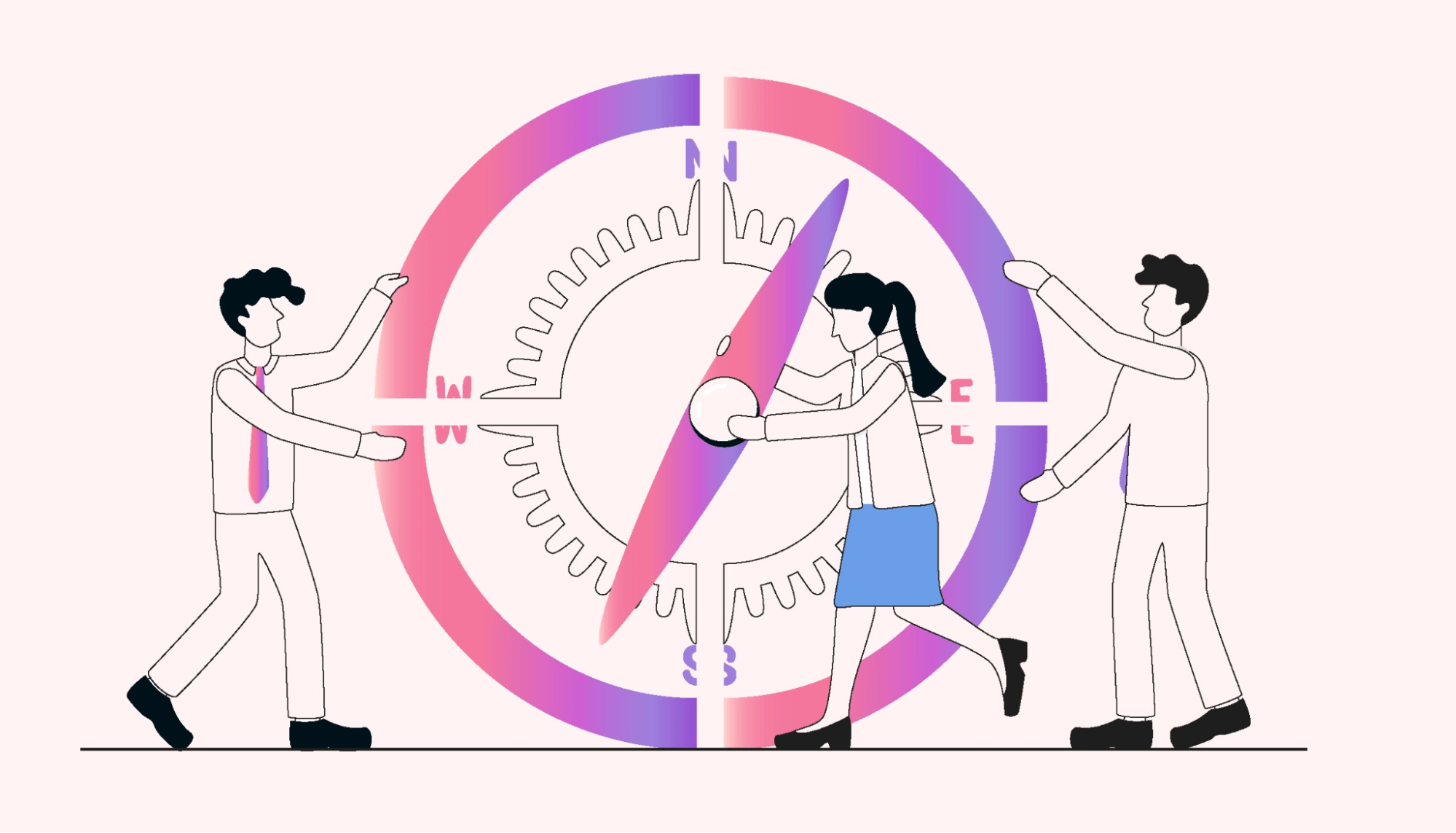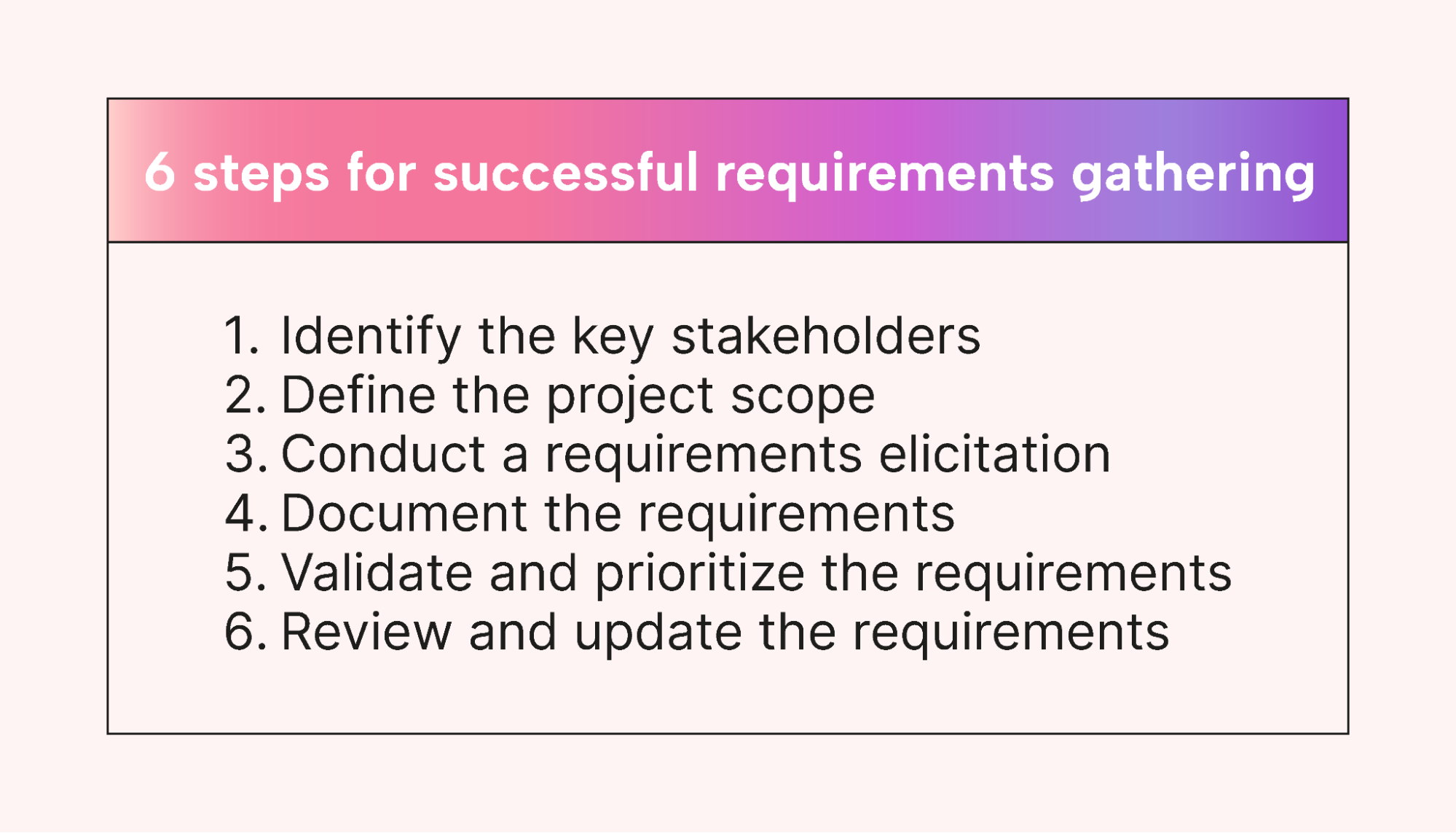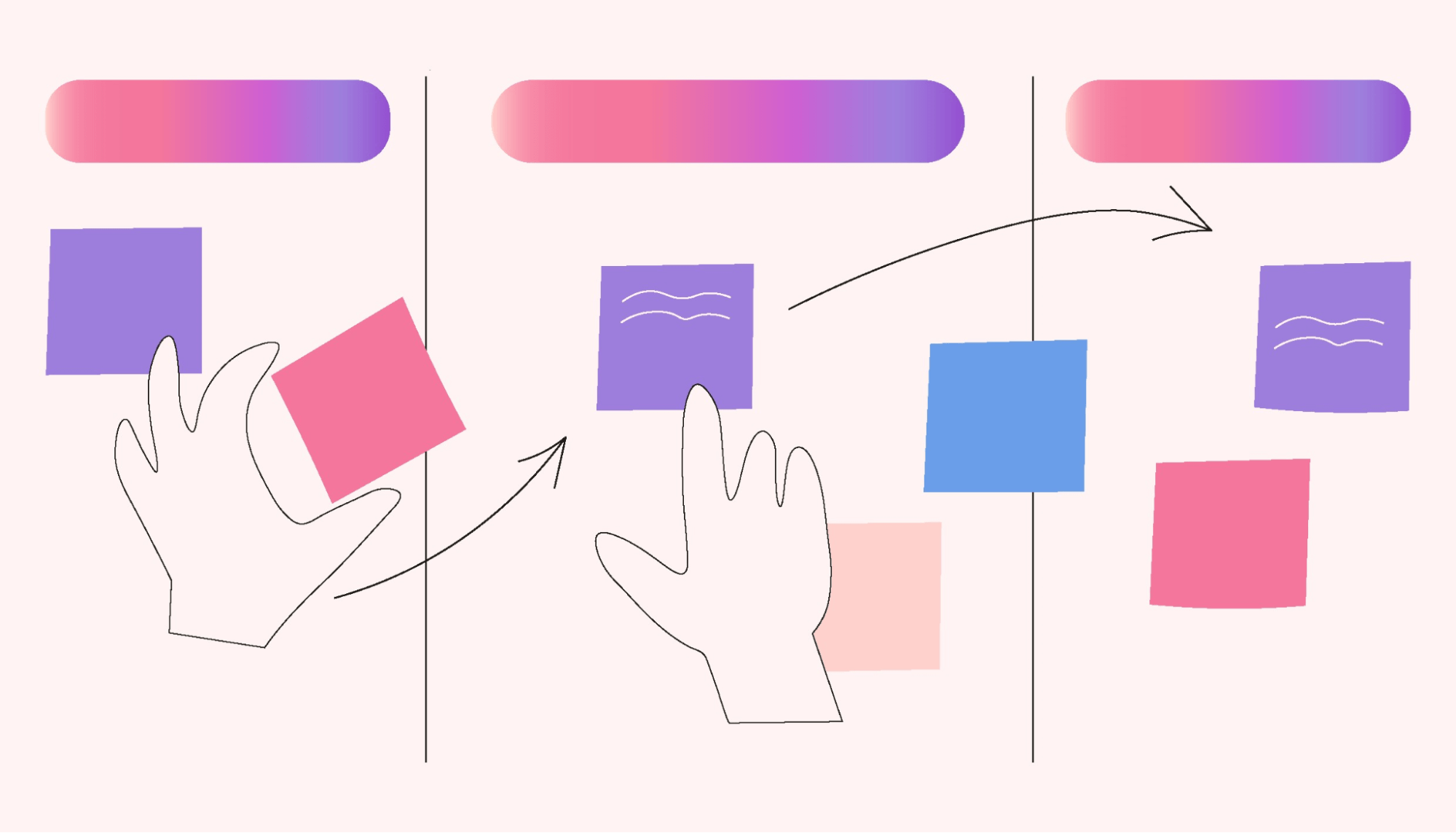Every great architectural marvel begins with a detailed blueprint.
In project management and development, these blueprints are formed through a process called requirements gathering.
The journey from ideation to realization is streamlined when we have a clear roadmap — and that’s precisely what effective requirements gathering provides.
This article will discuss requirements gathering in detail, including what it is, why it’s important, and the steps in the process.
What is requirements gathering?
Requirements gathering is the process of determining what a new or modified product should do. It involves talking to users and other key people to understand and document their needs and desires.
In software development or project management, requirements gathering is a way to make sure the end product matches what users and stakeholders want.
Why is gathering requirements important?
Did you know that 35% of failed projects fall short due to inaccurate requirements gathering? This staggering statistic underscores just how pivotal this phase is to a project’s success.
Gathering requirements has the following benefits:
Clear direction
It acts as a compass for a project or product. Obtaining a clear and detailed understanding of the goals and expectations allows teams to establish a firm foundation. From inception to completion, every decision and action aligns with the intended vision, preventing aimless wandering or misaligned efforts.
 |
Better stakeholder satisfaction
At the heart of any project or product are its users and stakeholders. Understanding and meticulously documenting their needs ensures that the end result is tailored to their expectations. This not only leads to a higher acceptance rate but also builds trust and fosters positive relationships among everyone involved.
Avoids wastage
Venturing into a project without a clear roadmap can lead to redundancy or misguided efforts. By solidifying business requirements from the outset, teams can prioritize tasks and avoid the pitfalls of unnecessary work or backtracking, ensuring that every step taken is purposeful and productive.
Reduces risks
Every project comes with uncertainties and potential hurdles. Through the process of gathering requirements, these challenges can be anticipated, and strategies to address them can be crafted.
This proactive approach safeguards against complications, resulting in fewer risks.
Ensures cost efficiency
Unplanned changes, late-stage modifications, or course corrections can considerably inflate a project’s budget. Pinning down requirements early makes it easier to allocate resources carefully and prevent unexpected financial strains as the project progresses.
Facilitates communication
As a project evolves, multiple teams and individuals become part of the journey. Having a comprehensive requirements document serves as a touchstone to ensure that all parties have a unified understanding. This fosters clear team communication, reduces ambiguity, and ensures everyone marches to the same beat — ultimately promoting collaboration.
The requirements-gathering process in 6 steps
Below are the typical steps involved in the requirements gathering process. Following them will increase the likelihood that your project is completed on time and within budget.
We will use an example of a team developing a mobile banking app to better portray each step.
 |
1. Identify the key stakeholders
Identify all the people or groups who have an interest in the project’s outcome. This step involves classifying stakeholders based on their influence and interest, assessing their engagement levels, and establishing clear communication channels with them.
Stakeholders can include customers, end-users, developers, project managers, business analysts, and regulatory bodies.
Understanding and documenting stakeholders’ interests helps teams align the project with stakeholder expectations and business objectives from the get-go.
Example
For our example of a mobile banking app, the identified stakeholders are as follows:
- Bank executives: These individuals want to offer online banking facilities to increase customer satisfaction and reduce the workload at physical branches.
- Bank customers: These are the end-users — those who will use the app for various banking activities.
- IT team: This group will develop, test, and maintain the app.
- Customer service representatives: These individuals will provide support to users and, therefore, need to understand the app’s functionality.
- Compliance and security teams: These stakeholders will ensure the app meets regulatory standards and is secure against potential threats.
2. Define the project scope
This is the phase where the project’s boundaries and scope are defined. It involves understanding what needs to be delivered and the project’s objectives, constraints, assumptions, and any known risks.
It’s essential to have a clear project scope, as it sets the groundwork for what is expected and what is not included in the project.
Example
The mobile banking app will offer:
- Balance inquiries
- Fund transfers between accounts and to other banks
- Bill payments
- Account statement downloads
- Mobile check deposits
- Alerts and notifications
The project will not include a chatbot or international transfers in its first version.
3. Conduct a requirements elicitation
Use different techniques, such as interviews, surveys, workshops, or focus groups, to gather detailed information, such as needs, expectations, and requirements, from the stakeholders. Effective elicitation is crucial, as it directly impacts the accuracy and completeness of the requirements gathered.
Example
The requirements elicitation for the mobile banking app will include the following:
- Interviews: Conduct one-on-one interviews with a diverse group of customers to understand what they expect from a mobile banking app.
- Surveys: Send out online surveys to a larger group of customers to get their input on potential features.
- Workshops: Organize a brainstorming workshop with the IT team and customer service reps. Encourage creative thinking with mind maps to visualize potential challenges and solutions.
4. Document the requirements
As you gather the requirements, document them clearly and concisely. Your comprehensive list should be easy for both technical and non-technical stakeholders to understand. This usually includes functional, non-functional, and transitional requirements.
Good documentation ensures that all stakeholders have a shared understanding of the project requirements.
Many teams use tools like Requirements Management Systems for this purpose.
Example
The team would document the following requirements for the mobile banking app:
- Functional requirements: These requirements are detailed descriptions of all the functionalities mentioned in the scope. For example, “Users should be able to set up recurring bill payments.”
- Non-functional requirements: These include performance (e.g., “The app should load the account balance within three seconds”), security (e.g., “The app should have two-factor authentication”), and other operational requirements.
- User stories: For example, “As a user, I want to deposit checks via my smartphone camera so that I don’t have to visit the bank.”
5. Validate and prioritize the requirements
Once the requirements are documented, get them validated by the stakeholders to ensure they are complete, feasible, and needed. Prioritize them based on the project goals, stakeholder needs, and resource constraints.
 |
Example
The mobile banking app team could do the following:
- Share the documented requirements with the stakeholders for validation. For instance, confirm with the compliance team that the outlined security measures are sufficient.
- Prioritize the requirements. While all features are important, fund transfers and balance inquiries might be deemed more critical to launch than mobile check deposits.
- Flag any requirements that are “nice-to-haves” for potential inclusion in future versions of the app.
6. Review and update the requirements
Review the documented and validated requirements, making any necessary updates based on feedback from stakeholders or changes in project constraints.
This step helps ensure the ongoing relevance and accuracy of the requirements throughout the project. It should happen several times. For example, you might review and update when new information emerges or project circumstances change.
Example
As development progresses, hold regular review meetings with stakeholders to verify that the app aligns with your requirements. Update the requirements if necessary. For instance, if, during development, the IT team finds a security vulnerability in the mobile check deposit feature, this requirement might be updated or postponed to a later version.
10 questions to help you gather requirements
When gathering requirements for a project, the questions you ask will depend on the project’s context. These questions will provide a starting point for gathering project requirements and can be customized based on the project’s nature and scope.
- Project overview: What is the primary goal or objective of the project?
- Stakeholders: Who are the key stakeholders, and what are their roles and responsibilities in relation to the project?
- Users and audience: Who are the end users of, or target audience for, this project? Are there any user personas or profiles we should be aware of?
- Functional requirements: What main features or functionalities do you envision for this project? Can you provide use cases for each?
- Non-functional requirements: Are there specific performance, security, or design standards that need to be met?
- Data and integration: Will this project require integration with any existing systems or platforms? If so, can you provide details?
- Constraints: Are there any budgetary, time, or technological constraints we need to be aware of?
- Success metrics: How will the project’s success be measured? Are you targeting any specific KPIs or outcomes?
- Risks and concerns: Are there any potential risks, challenges, or concerns you anticipate for this project?
- Priorities: Of the requirements or features discussed, which are the most critical or time-sensitive, and which can be considered for future phases or versions?
Techniques for gathering requirements
There are many methods of gathering, documenting, and verifying requirements from stakeholders. Here are some of the most common ways to gather requirements:
Surveys and questionnaires
Design and distribute surveys or questionnaires to stakeholders to gauge their needs, preferences, and expectations for the project. These tools can help you collect preliminary information, which can be analyzed to draft the initial requirements.
Surveys and questionnaires are especially useful if you need to reach a large number of stakeholders or look for statistical data to inform decisions.
Interviews
Conduct one-on-one or group interviews with key stakeholders to gather in-depth insights into their expectations, the challenges they foresee, and the goals they aim to achieve with the project.
Through interviews, you can explore complex issues and requirements in detail, ensuring a thorough understanding that can be translated into well-defined project requirements.
Brainstorming
Organize brainstorming sessions with project teams and stakeholders to explore ideas, solutions, and potential requirements.
 |
This collaborative approach encourages diverse thinking and can help uncover innovative solutions or requirements that may not have been considered initially. The ideas that are generated can then be refined and formalized into actionable project requirements.
Prototyping
Create early prototypes or mock-ups of the system or product being developed to visualize and test possible solutions against the gathered requirements. Share these prototypes with the project stakeholders for feedback, as this can help further refine the requirements. This iterative process can help ensure that the final product aligns well with stakeholders’ expectations and the project’s goals.
Storyboarding
Use storyboarding to visually represent user journeys, process flows, or system interactions. This technique can help to communicate and validate the requirements in a clear and engaging manner.
By visualizing different scenarios, stakeholders can better understand the proposed solutions and provide valuable feedback to refine the requirements.
Turn your requirements into results with Motion
Navigating the maze of requirements gathering is crucial to propelling your projects from the drawing board to reality, and Motion can help guide you along the way.
With Motion’s adept task management features, every requirement is meticulously tracked, assigned, and managed — ensuring a streamlined pathway from inception to completion. Whether you’re juggling multiple projects at once or focusing on a singular task, Motion provides a central hub to oversee all requirements, fostering a culture of accountability and precision.
Motion’s user-friendly interface, coupled with its robust functionality, makes requirement management a breeze, accelerating project timelines and enhancing productivity.
Take the first step toward structured and results-driven project execution with Motion’s comprehensive task management suite. Sign up for a free 7-day trial.





